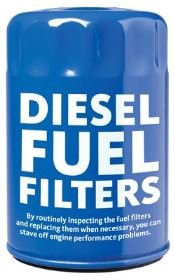By routinely inspecting the fuel filters and replacing them when necessary, you can stave off engine performance problems.
By Brett Wolfe, F252125
October 2012
The typical fuel system on a diesel-powered motorhome is arranged in the following order: fuel tank, primary fuel filter/water separator, lift pump, secondary fuel filter, and engine. With the above system, either a 10-micron or a 30-micron coarse primary filter element is used along with a 2-micron to 5-micron secondary filter element. The final filter micron rating is specified by your engine manufacturer. If the fuel system includes only one fuel filter, the filter element must be the micron rating specified by the engine manufacturer, in most cases either a 2-micron or a 5-micron element.
But here’s the problem. Say you go to a dealer and ask the person at the parts counter for a fuel filter element for your particular motorhome chassis or engine. If the last four filter elements the parts person sold were for the two-filter system, it is quite likely that he or she will just hand you a 10-micron or 30-micron filter. It will fit, but you will end up spending a lot of money to get the “rocks” out of the injectors. Actually, you probably will end up replacing the injectors if your motorhome’s fuel system uses a single fuel filter. By the same token, if you have the two-filter system and the last four filter elements the parts person sold were for the single-filter system, it is quite likely that he or she will hand you a 2-micron or 5-micron element, which is almost as bad. You now have a 2-micron element followed by another 2-micron element. The first filter in line will clog up quickly and the second will remain clean.
So, make sure you specify the micron rating(s) for the filter element(s) you need for your application. Better yet, know the part number(s) for the correct element(s). Consult the chassis or engine manufacturer for the correct part numbers. This information also should be available in your owners manuals.
It’s very important that you follow the engine and/or chassis manufacturer’s recommendation for the proper filter replacement procedure. Some call for the filters to be installed dry and primed with the use of a manual primer pump; some require the filters to be prefilled with diesel fuel; some use an electric fuel pump to prime. What works well on one engine or chassis may not be correct for yours.
If the instructions for your system mandate that the filters be prefilled with clean diesel fuel before installation, be sure, particularly on the secondary fuel filter, to fill only the small outer holes (inlets), not the large center hole (outlet). Anything that goes into the center hole will go directly to the injectors with no filtration! Sure, it will take much longer to fill it this way, but it is safer than hoping that you have no contaminants in the fuel. Trust me; you cannot see 5-micron particles with the naked eye. Unlike most maintenance items, there is no average lifespan for a fuel filter. If all that ever passes through it is clean fuel, the filter could remain in good condition for years. But one tank of contaminated fuel is capable of clogging several sets of filters.
It is recommended that you always carry at least one extra set of fuel filters with you whenever you travel. You can find someone to install a filter virtually anywhere, but you may not always be able to find the proper filter element where you happen to be. After purchasing a filter, mark the date on the box so you use the oldest filter first, and buy a new filter to replace it in your motorhome’s parts bin.
If you have a filter with a clear bowl — I prefer this type, as I can see at a glance if there is contamination in the fuel — make sure to buy a spare plastic bowl. These bowls can crack, and it is much easier to fit the bowl on the new filter before you even start changing filters. Then take the current plastic bowl — if it is still in good condition — and make it the spare for the next filter change.
Modern diesel engines utilize high-bypass fuel systems. What this means is that for every gallon of diesel fuel pumped through the engine, only a few ounces are burned. The rest is used to cool and lubricate the head and is returned to the fuel tank. In practical terms, this makes it quite easy to determine the quality of the fuel. The next time you stop after refueling, you should visually check the primary filter (those with a clear bowl filter), as dirt and water will show up very quickly if present in the fuel.
If any diesel engine begins to lose power under heavy throttle conditions, the first thing to do is to replace the fuel filters. Why? Because changing the filter is easy, reasonably inexpensive, and often is the cause of the problem. Clogged filters typically are found to be the primary reason for performance issues under high-throttle conditions, since that is when maximum fuel flow is required. Sure, there can be other causes for performance loss, but the fuel filter is almost always a reasonable place to start.

